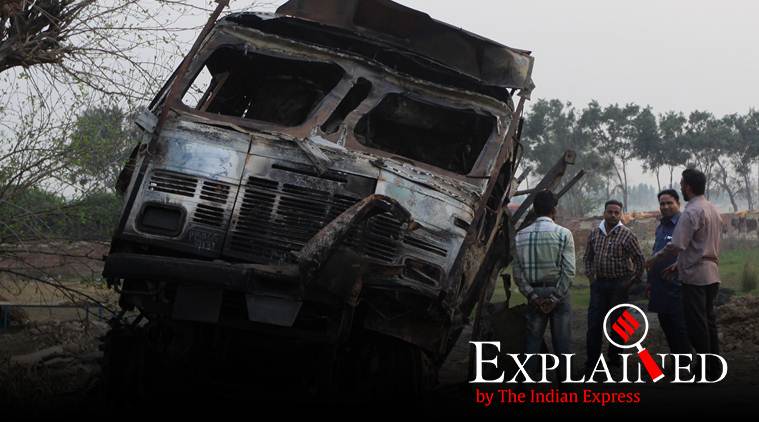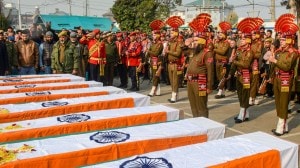Explained: As Haryana votes on May 12, the vexed issue of Jat reservation
As Haryana votes on Sunday for its 10 Lok Sabha seats, the shadow of the 2016 protests looms over a divided electorate, especially in the Jat heartland of Jhajjar and Rohtak.
 A truck was set ablaze in Murthal, Haryana, during the Jat protests in 2016. (Express File Photo: Prem Nath Pandey)
A truck was set ablaze in Murthal, Haryana, during the Jat protests in 2016. (Express File Photo: Prem Nath Pandey)
Three years ago, waves of violence raced through Haryana as thousands of members of the Jat community took to the streets demanding reservation. At least 30 were killed, dozens injured, and scores of shops and buildings ransacked and set ablaze. As Haryana votes on Sunday for its 10 Lok Sabha seats, the shadow of the 2016 protests looms over a divided electorate, especially in the Jat heartland of Jhajjar and Rohtak.
The Jats are among the most dominant communities in several states of the country, including Haryana. Successive governments, both of the Congress and BJP, have made repeated attempts to keep the Jats happy by promising them reservations in government jobs and educational institutions. Steps have been initiated on several occasions, but the issue of reservation continues to remain entangled in litigation.
The key reason for the failure to implement the Jat quota is that it breaches the 50 per cent ceiling for reservations set by the Supreme Court. The demands of the protesters of February 2016 can probably be met only with an amendment in the Constitution of India.
Explained: Jat agitation in 2016
For the last many years, the Jats in Haryana had been staging protests against the then governments, seeking reservation in educational institutions and government jobs. They had staged massive agitations during the Congress’s 10-year rule from 2004 to 2014 as well, seeking reservation. Highways and rail tracks would be blocked by large numbers of Jat protesters for days together. The agitations would typically cease following assurances by politicians.
In October 2014, the BJP came to power in Haryana with a clear majority for the first time. A non-Jat became Chief Minister, breaking the tradition of mostly Jat heads of government in the history of the state. From January 2016, Jats started squatting on highways, and taking out protest marches. By the first week of February, the protests started gaining momentum not only in the Jat-dominated areas of Rohtak, Jhajjar, Jind, Sonipat and Hisar, but in various other parts of the state as well.
As frustration and simmering anger against the government headed by a non-Jat leader boiled over, Jat leaders in the BJP tried to pacify the protesters, but in vain. The Jats eventually went on the rampage, and the BJP, a novice in running the government in Haryana, looked towards the Centre and relied completely upon the paramilitary forces, followed by the Army, to control the situation. Since a large number of Jats held administrative posts in district administrations and the police, there was a clear lack of will to act against the protesters, further crippling the effort to curb the agitation.
Don’t miss in Explained | Why Akhilesh curtailed his campaign for fear of exceeding EC’s ceiling on poll expenses
What did BJP government do to ensure quota for Jat community?
Within a month of the violence that left 30 persons dead, property worth hundreds of crores gutted, and damage done to the social fabric of the state, the BJP came up with legislation to provide 10 per cent reservation to Jats and five other castes – Bishnois, Rors, Tyagis, Mulla/Muslim Jats, and Jat Sikhs. In March 2016, the Haryana Assembly passed two Bills: The Haryana Backward Classes (Reservation in Services and Admission in Educational Institutions) Bill, 2016, which proposed to give statutory status to Backward Classes Block ‘A’, Backward Classes Block ‘B’, and Backward Classes Block ‘C’; and The Haryana Backward Classes Commission Bill, 2016, which proposed to set up a permanent mechanism and give statutory status to the Haryana Backward Classes Commission.
On September 1, 2017, the Punjab and Haryana High Court upheld the reservation, but stayed its implementation until March 31, 2018. The HC also added that the extent of reservation shall be determined by the State Backward Classes Commission on the basis of data provided either by the state government, or collected by the Commission on its own.
The Commission has, so far, not submitted its report to the government. The Haryana government sent its legislation to the Union government for inclusion in the Ninth Schedule of the Constitution, as the proposed reservation breached the 50 per cent ceiling set by Supreme Court.
However, the items in the Ninth Schedule, which were originally protected from judicial scrutiny, are now no longer entirely immune. The Supreme Court, in I R Coelho v State of Tamil Nadu (2007), ruled that laws that violated the basic structure of the Constitution would be open to judicial review, including any law added to the Ninth Schedule after April 24, 1973.
The state government’s move was challenged in the Supreme Court, and it remains pending there.
What did the previous Congress govt do to ensure reservation for Jat community?
A few months before the 2014 polls, the Congress government, in December 2013, announced a 10 per cent quota for Jats and other castes by way of a Cabinet decision. On March 4, 2014, the Centre also announced quota to Jats and others in central government jobs and educational institutions.
But the Supreme Court set aside the quota in central government jobs. Thus, reservation provided to the Jats and other castes by the Congress government in Haryana too, was declared ultra vires of the Constitution.
What is the solution that the protesting Jat leaders give?
Jat leaders suggest that Jats and other castes should be included in the “Backward Classes” category, which is already covered under the 27 per cent quota. In this 27 per cent, 16 per cent reservation is given to the more backward categories (BC-A), and 11 per cent to the BC-B that includes Sainis, Yadavs, Gujjars, Ahirs, Kurmis and Lodhas.
The Jats are demanding that they should be included in the BC-B category at least, after the share of this category is upped to 14 per cent, creating room in the tent for them and other castes. However, the government has argued that such a move would not be legally tenable, and would disturb the Backward Classes reservation.



- 01
- 02
- 03
- 04
- 05



































